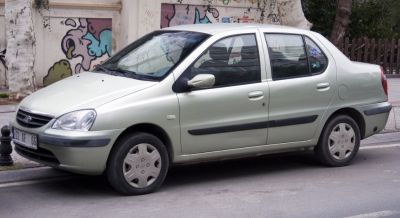 1964 Moskvich 408 Dimensions, Size & Specs
1964 Moskvich 408 Dimensions, Size & SpecsMeasurements of the 1964 Moskvich 408, engineered for optimal performance and comfort
| Dimensions | |
|---|---|
| Length: | 4090 mm161.0 in13.4 ft |
| Width: | 1550 mm61.0 in5.1 ft |
| Height: | 1480 mm58.3 in4.9 ft |
| Trunk Capacity: | 372 liter13.1 cu ft |
| Weight Specifications | |
| Curb Weight: | 990 kg2183 lbs |
| Maximal permitted Weight: | 1330 kg2932 lbs |
The Moskvich 408 is a classic Soviet-era sedan produced between 1964 and 1969, representing an important chapter in Eastern European automotive history. This generation of the Moskvich 408 features a compact yet practical design ideal for everyday use during its production years. Measuring 4090 mm (161.0 inches) in length, 1550 mm (61.0 inches) in width, and standing 1480 mm (58.3 inches) tall, it offers a balanced footprint for maneuverability and urban driving. Despite its relatively modest dimensions, the 408 sedan provides a respectable curb weight of 990 kg (2183 lbs) and a maximum weight capacity of 1330 kg (2932 lbs), ensuring solid road presence without compromising fuel economy for its time. The interior is complemented by a generous luggage capacity of 372 liters (13.1 cubic feet), allowing for sufficient storage space for daily errands or small family trips. As a four-door sedan, the Moskvich 408 was designed to accommodate passengers comfortably while maintaining simplicity and functionality, typical for vehicles of the 1960s Soviet automotive market. Its compact stature and practical features make it an interesting model for enthusiasts of vintage cars and those interested in vehicle size comparisons within the classic car segment.
Discover the standout features that make the 1964 Moskvich 408 a leader in its class
Have a question? Please check our knowledgebase first.
The Moskvich 408 sedan, produced between 1964 and 1969, measures 4,090 mm (161.0 inches) in length, 1,550 mm (61.0 inches) in width, and has a height of 1,480 mm (58.3 inches). These compact dimensions reflect the car's design focus on being a practical and efficient family sedan during its era, offering a familiar size compared to other mid-size cars of the 1960s.
The Moskvich 408 has a curb weight of approximately 990 kg (2,182 lbs), which is the vehicle's weight when empty but with all standard equipment and fluids. Its maximum weight capacity is rated at around 1,330 kg (2,932 lbs), meaning it can safely carry passengers, cargo, and fuel up to this limit without compromising handling and performance. This weight range made it relatively lightweight for its time, contributing to acceptable fuel economy and manageable driving dynamics.
Yes, the Moskvich 408 features a luggage compartment with a capacity of 372 liters (approximately 13.1 cubic feet). This is a reasonably generous trunk space for a sedan from the 1960s, allowing for the storage of several suitcases or bags, making it suitable for family trips or regular errands. The size reflects the practical design approach Moskvich took, emphasizing usability alongside modest overall vehicle size.
With a width of 1,550 mm (61.0 inches), the Moskvich 408 is quite compact compared to many contemporary vehicles, making it highly maneuverable in narrow city streets and tight parking areas. This relatively narrow profile was advantageous during the 1960s Soviet urban environments where roads and parking might be constrained. It allows drivers to navigate through congested traffic and park in smaller spaces with greater ease than wider vehicles.
A standard residential garage typically measures around 2,400 mm (94.5 inches) in width and 4,800 mm (189 inches) in length. The Moskvich 408, at 1,550 mm (61.0 inches) wide and 4,090 mm (161.0 inches) long, easily fits into standard garages with room to spare on both sides and in front or rear. This makes parking and storage convenient for owners, especially given the car's relatively low height of 1,480 mm (58.3 inches), which poses no clearance issues.
With a height of 1,480 mm (58.3 inches), the Moskvich 408 offers a balanced stance typical of sedans from its era. This height provides reasonable interior headroom for passengers, making the cabin comfortable for average-sized adults. The design achieves a low center of gravity, which helps in vehicle stability and handling. While not exceptionally tall, the height gives adequate space vertically inside the cabin without compromising aerodynamic efficiency or stylish proportions.
Compared to its predecessor, the Moskvich 407, the 408 model saw a slight increase in dimensions reflecting design and comfort improvements. While the 407 measured approximately 4,020 mm in length, the 408 extended to 4,090 mm, gaining more interior and trunk space. Width and height changes were minimal but enough to enhance passenger comfort. The 408's improved size made it more practical for everyday use, offering better ergonomics and a more modern aesthetic than the 407.
In comparison to other mid-size sedans of the 1960s, such as the Opel Rekord or the Ford Cortina, the Moskvich 408 was somewhat more compact and lighter. While typical mid-size cars ranged from about 4,200 mm to 4,400 mm in length, the 408's 4,090 mm length was on the shorter side. Its curb weight of 990 kg also was lighter than many peers, which often weighed between 1,100 to 1,300 kg. This made the 408 more agile and economical but less spacious inside.
The relatively lightweight 990 kg (2,182 lbs) curb weight positively influenced the Moskvich 408's fuel efficiency and general performance. Being lighter allowed the small-displacement engine to propel the vehicle effectively without excessive fuel consumption. The lower weight also contributed to more manageable handling and better braking performance than heavier cars from the same period. This was important in the 1960s when fuel economy was a practical concern in many markets, especially in the Soviet Union.
The Moskvich 408 is a classic Soviet-era family sedan produced from 1964 to 1969. It is historically significant for its robust yet straightforward design aimed to serve the expanding middle-class market in the USSR and its satellite states. Known for reliability and ease of maintenance, the 408 was popular for daily use and offered a reasonable interior space with a solid build. It represented technological progress over earlier models and helped establish Moskvich as a key manufacturer in the mid-size car segment during that period.
Discover similar sized cars.

| Production: | 1969-1975 |
|---|---|
| Model Year: | 1969 |
| Length: | 4090 mm161.0 in |
| Width: | 1550 mm61.0 in |
| Height: | 1480 mm58.3 in |

| Production: | 2002-2009 |
|---|---|
| Model Year: | 2002 |
| Length: | 4150 mm163.4 in |
| Width: | 1620 mm63.8 in |
| Height: | 1540 mm60.6 in |

| Production: | 2020-present |
|---|---|
| Model Year: | 2020 |
| Length: | 4170 mm164.2 in |
| Width: | 1620 mm63.8 in |
| Height: | 1525 mm60.0 in |
